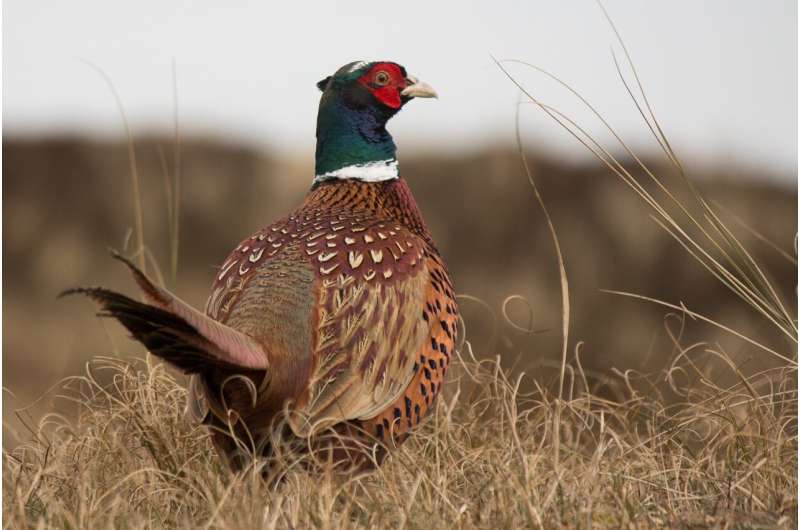This article has been reviewed according to Science X's editorial process and policies. Editors have highlighted the following attributes while ensuring the content's credibility:
fact-checked
peer-reviewed publication
trusted source
proofread
Pheasants at risk from predators on unfamiliar ground

Pheasants are most likely to be killed by predators on unfamiliar ground, new research shows.
Most animals live within a certain area, known as their home range, and they know the central areas better than the edges.
In the new study, led by the University of Exeter, 126 captive-reared pheasant chicks were tested on a range of cognitive puzzles before being released into the wild and tracked using a high-precision tagging system.
About 40% were killed by predators during the six-month study period, almost all by foxes—and the pheasants were far more likely to die toward the edge of their range.
The findings show this was due to inexperience in these areas, because other birds that knew the same spots well were not likely to die there.
"For pheasants, experience within an area is much more important for predicting whether they are killed by predators than how dangerous the area is itself," said lead author Dr. Robert Heathcote, now at the University of Bristol.
"Ambush predators like foxes are quite habitual in their hunting behavior, so local pheasants may learn particular locations where foxes prefer to stalk their prey or lie in wait.
"Another explanation is that, with time, pheasants might gain more knowledge about the fastest and safest escape routes should they be attacked.
"Our study suggests this might cause pheasants to evolve better spatial memory, allowing them to expand the region that they have detailed knowledge about."
The study assessed two kinds of spatial memory in each pheasant before their release, using a maze and a memory task.
The results showed chicks with high cognitive abilities grew up to have a larger range.
Dr. Mark Whiteside, now at the University of Plymouth, said, "One of the tasks we presented the chicks was to learn to navigate through a carefully designed maze to test for navigation-related spatial cognition including spatial reference memory.
"The ability to remember locations such as sites for foraging, drinking and refuge could explain why individuals that performed well on this task had larger home ranges after their release into the wild.
"Their performance in these tests that were administered when the birds were just a few weeks old went on to predict their chance of being killed by foxes months later."
Establishing cause of death was made possible by a novel state-of-the-art reverse-GPS tracking system developed by Professor Sivan Toledo, of Tel-Aviv University, and Dr. Yotam Orchan, of Hebrew University of Jerusalem.
The extraordinary accuracy of these tags meant the researchers were able to work out the exact timing, location and cause of any deaths of tagged birds.
"Our findings show that basic spatial abilities, revealed by tests in mazes, relate to real-world space use in the wild and, crucially, affect the survival of individuals in the face of predation," said Dr. Joah Madden, from the University of Exeter.
"We demonstrate that knowing about an area helps pheasants stay alive, and this means that these cognitive abilities can be shaped by natural selection.
"We now understand a bit more about how cognitive abilities can evolve."
The pheasants in the study were reared and released in Devon, England.
The paper, published in the journal Nature Ecology and Evolution, is titled "Spatial memory predicts home range size and predation risk in pheasants."
More information: Robert Heathcote, Spatial memory predicts home range size and predation risk in pheasants, Nature Ecology & Evolution (2023). DOI: 10.1038/s41559-022-01950-5. www.nature.com/articles/s41559-022-01950-5
Journal information: Nature Ecology & Evolution
Provided by University of Exeter


















